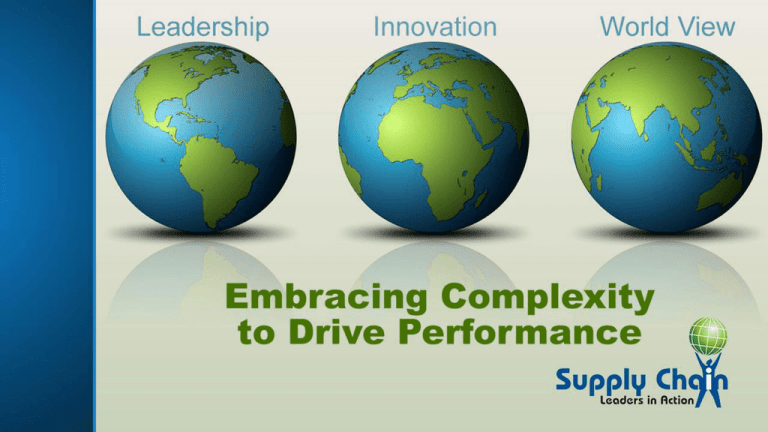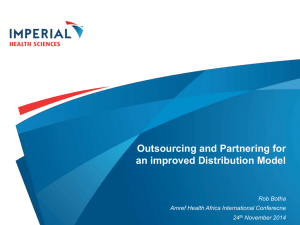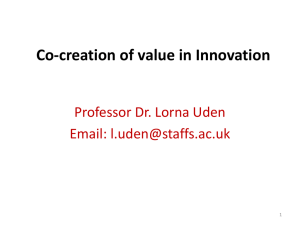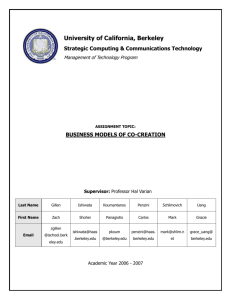What is a Supply Chain? - Distribution Business Management
advertisement

Building High Performance Business Relationships to Co-Create Value Douglas M. Lambert, Ph.D. Raymond E. Mason Chaired Professor Director of The Global Supply Chain Forum Fisher College of Business, The Ohio State University What is a Supply Chain? A. A business function B. A network of companies A Supply Chain is a Network of Companies Tier 2 Suppliers Tier 2 Customers 1 1 2 2 n Initial Suppliers Tier 1 Customers Tier 1 Suppliers n 1 1 1 n 2 2 1 2 3 3 1 3 n Tier 3 to Consumers/ End-users n n 1 1 n n Managed Process Links Monitored Process Links Not-Managed Process Links Non-Member Process Links 1 n Consumers/End-users Tier 3 to Initial suppliers n 1 2 n Focal Company Members of the Focal Company’s Supply Chain Non-members of the Focal Company’s Supply Chain Source: Douglas M. Lambert, Editor, Supply Chain Management: Processes, Partnerships, Performance, Fourth Edition, Ponte Vedra Beach , FL: Supply Chain Management Institute, 2014, p. 264. The competition is no longer between companies but between supply chains. A. True B. False Typically Competitors Buy from the Same Suppliers and Sell to the Same Customers Tier 2 Suppliers Tier 1 Customers Tier 1 Suppliers 1 1 2 2 n n 1 2 2 1 2 3 3 n 1 n 1 1 n n Managed Process Links Monitored Process Links Not-Managed Process Links Non-Member Process Links 1 n 3 n Tier 3 to Consumers/ End-users n 1 1 Initial Suppliers Tier 2 Customers 2 n Colgate P&G Unilever Source: Douglas M. Lambert, Editor, Supply Chain Management: Processes, Partnerships, Performance, Fourth Edition, Ponte Vedra Beach , FL: Supply Chain Management Institute, 2014, p. 7. Consumers/End-users Tier 3 to Initial suppliers CRM and SRM Form the Links in the Supply Chain CRM Customer Service Management Demand Management Supplier Order Fulfillment Customer Manufacturing Flow Management Product Development and Commercialization Returns Management SRM © Copyright, 2010, Douglas M. Lambert Building High Performance Business Relationships • Partnership Model • Collaboration Framework Why do partnerships fail? A. Unrealistic expectations on the part of one or both organizations B. Expectations are not disclosed by the parties involved C. Lack of common vision within each organization D. All of the above Partnership - Definition A partnership is a tailored business relationship based on mutual trust, openness, shared risk and shared rewards that results in business performance greater than would be achieved by two firms working together in the absence of partnership. © The Global Supply Chain Forum, 2000 Source: Douglas M. Lambert, Editor, Supply Chain Management: Processes, Partnerships, Performance, Fourth Edition, Ponte Vedra Beach , FL: Supply Chain Management Institute, 2014, p. 277. Types of Relationships Partnerships Arm’s Length Type I Type II Type III Joint Ventures Vertical Integration Source: Douglas M. Lambert, Editor, Supply Chain Management: Processes, Partnerships, Performance, Fourth Edition, Ponte Vedra Beach , FL: Supply Chain Management Institute, 2014, p. 277. Partnership Strategy • Partnerships are costly to implement • Not all relationships should be partnerships • Partnership strategy should be driven by overall corporate strategy • The Partnership Model developed by The Global Supply Chain Forum is a tool for developing and managing partnerships The Supply Chain Management Institute, 2008. The Partnership Model Drivers Compelling reasons to partner Drivers set expectations of outcomes Decision to create or adjust partnership Facilitators Supportive environmental factors that enhance partnership growth Components Joint activities and processes that build and sustain the partnership Feedback to: Outcomes • Components • Drivers • Facilitators The extent to which performance meets expectations Source: Douglas M. Lambert, Editor, Supply Chain Management: Processes, Partnerships, Performance, Fourth Edition, Ponte Vedra Beach , FL: Supply Chain Management Institute, 2014, p. 280. The Collaboration Framework Assessment of Drivers Drivers are business reasons for expanding the resource commitment to the relationship. For each item, develop specific goals and identify the priority. Priority is: 1=Critical, 2=Very Important, 3=Important. ASSET/COST EFFICIENCY 1. What are the initiatives that will reduce cost or improve asset utilization? Driver • Product costs savings • Distribution costs savings, handling costs savings • Packaging costs savings and green initiatives • Reduce order-to-cash cycle time • No management time devoted to conference call to key customers explaining service failures due to supplier problems • Assets utilization (reduce plant over-time due to surprise orders) • Integrate planning across business and plants (visibility of capacity available across plants) Goal Priority 2% per year 1 7% during 1st year 1 Satisfy Wal-Mart’s requirements 3 By 10 days 2 Zero within 3 months 1 No surprise orders by quarter-end 2 Within 12 months 3 The Supply Chain Management Institute, 2010 Assessment of Drivers Drivers are business reasons for expanding the resource commitment to the relationship. For each item, develop specific goals and identify the priority. Priority is: 1=Critical, 2=Very Important, 3=Important. ASSET/COST EFFICIENCY 1. What are the initiatives that will reduce cost or improve asset utilization? Driver Goal Priority Align Expectations • Each team presents their drivers • Rationale for each driver given • Agreement by both teams that the driver can become a joint goal • Drivers will not necessarily match Develop Action Plan • The teams jointly determine and prioritize initiatives • The set of initiatives should be relatively small • There should be a balance of short-term and longterm initiatives • The action plan needs to include clear statements of what is to be done, who is responsible, and a timeline for results Does your organization use cross-functional teams to engage key customers and suppliers? A. Yes B. No Research Questions • Does cross-functional involvement in business-to- business relationships lead to the co-creation of value? • Are perceptual measurements of value co-creation good enough in business-to-business contexts? Understanding the Enablers of Value Co-Creation Bob Evans is a full-service restaurant chain. Owns and operates more than 700 restaurants in 29 states of USA. The BEF group also sells branded products to major grocery retailers. Revenues are in excess of $1.5 billion. Purchases from A: $16.7 million The relationship was cross-functional Purchases from B: $18.5 million The relationship was NOT cross-functional Supplier A Supplier B Global food company Revenues in excess of $40 billion Global food company Revenues in excess of $40 billion Initial Perceptions of the Value of Each Relationship • All managers at the Restaurant Company perceived that Supplier A was creating more value (compared to Supplier B). • Managers attributed the higher value created with Supplier A to the existence of cross-functional teams. • Cross-functional involvement enabled a better understanding of the other company’s needs and competences (manifest and latent). • Managers did not understand the magnitude of the difference in profitability because they could not quantify the value created in financial terms. Importance of Measuring Value Co-creation in Financial Terms Restaurant Company purchases from Supplier A and Supplier B for the Years 2008 to 2011 Supplier A Supplier B 2008 $16,682,275 $18,471,595 2009 $15,641,571 $14,226,747 2010 $15,618,038 $11,164,415 2011 $18,232,230 $5,143,524 Research started Financial results of value cocreation given to managers Financial results * Projected value co-creation for 2010 for Restaurant Company : • From the relationship with A: $25.87 million (*) measured as the contribution towards the joint costs and fixed costs of Company As of the initiatives conducted in the relationships. • From the relationship with B: $0.36 million “Any supplier who wants to be viewed as strategic must have the willingness and capability to work in cross-functional teams and think in terms of value co-creation.” Richard Hall EVP of Supply Chain Management Bob Evans Farms Bob Evans Old Distribution Network A B C B and C A and B A and C A, B and C Focus for RFP Evaluation Evaluate the capabilities of the participating distributors in terms of: Food Safety Programs IT Capabilities East/West Distribution Options Recovery in the event of a DC disaster Utilization of the same DCs for both restaurant formats Their financial stability Co-Creation of Value Costs to be incurred Savings to be generated Savings Over the Old Distributor Network TOTAL SELECTED DISTRIBUTOR A B C $2,600,000 $1,200,000 $5,300,000 $3,200,000 $2,700,000 The Collaboration Framework Outcomes of One-day Collaboration Meeting • The BEF team identified 18 drivers • The GFS team identified 22 drivers • 10 of the total of 40 drivers were similar for both companies • 38 drivers were accepted as joint goals Co-Creation of Value Results: First Year Company Restaurant Company Driver Asset / cost efficiency Asset / cost efficiency Asset / cost efficiency Asset / cost efficiency Asset / cost efficiency Asset / cost efficiency Asset / cost efficiency Marketing Advantage Profit stability / growth New initiative New initiative New initiative New initiative Initiative First Year Results Reduce proprietary vendors and SKUs Existing Vendor Evaluation Vendor Freight Management Fuel Contracting Increase backhauling Early pay discount Simplify courier services Sale of obsolete inventory Pricing for a specific region Chemical Program Consolidation of low volume retail items Storage of items of previous seasons at no cost Waffle Maker Return Sub-total Distributor Asset / cost efficiency Asset / cost efficiency Asset / cost efficiency New initiative New initiative Reduce proprietary vendors and SKUs Vendor Freight Management Simplify courier services Chemical Program Restaurant purchases from Distributor’s retail stores Sub-total Source: Douglas M. Lambert and Matias G. Enz, "Managing and Measuring Value Co-creation in Business-to-Business Relationships," Journal of Marketing Management, Vol. 28, Issue 13-14 (2012), p. 1600. TOTAL $ 234,546 180,613 31,820 592,001 576,609 288,003 5,393 9,526 225,522 1,008,447 72,826 94,549 14,535 $3,334,390 $ 72,750 24,866 8,088 850,000 75,705 $1,031,409 $4,365,799 Total for Year 2: $7.3 million Biggest Opportunities Are Still to be Implemented • Increased sales for restaurant company’s Food Products Division through distributor’s retail outlets • Support for Food Products Division presentations to Distributor’s other customers • Increased use of the distributor's main produce supplier • Distributor team makes culinary presentations to the restaurant company’s product development team Summary • Supply chain management is about relationship management • There are 2 tools that provide management with a structure to develop collaborative, cross-functional business relationships • Collaboration leads to value co-creation For more information see: http://fisher.osu.edu/centers/scm/ http://www.scm-institute.org/ http://www.thepartnershipmodel.com/ Questions??











